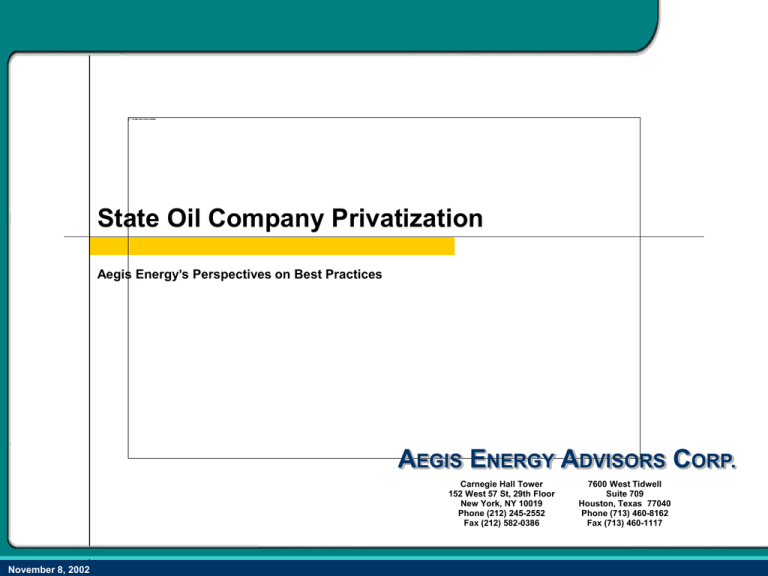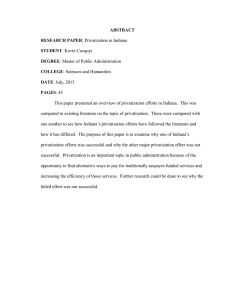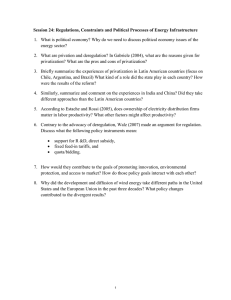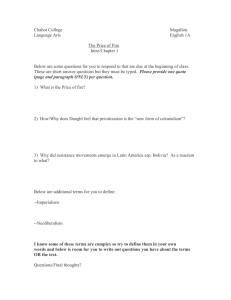
State Oil Company Privatization
Aegis Energy’s Perspectives on Best Practices
AEGIS ENERGY ADVISORS CORP.
Carnegie Hall Tower
152 West 57 St, 29th Floor
New York, NY 10019
Phone (212) 245-2552
Fax (212) 582-0386
November 8, 2002
7600 West Tidwell
Suite 709
Houston, Texas 77040
Phone (713) 460-8162
Fax (713) 460-1117
AEGIS ENERGY
ADVISORS CORP.
CONTENTS
Privatization Motivations
Privatization Goals
Privatization Methods
3
4
5
6
7
8
9
Best Practices:
Best Practices:
Best Practices:
Best Practices:
Restructuring
Promoting Competition
Political Risks
Process
Selected Privatization Synopsis
Argentina
Bolivia
Canada
China
Czech Republic
France
India
Italy
Lithuania
November 8, 2002
10
10
11
11
12
12
13
13
14
Mongolia
Norway
Philippines
Poland
Portugal
Russia
Spain
United Kingdom
Chinese Petroleum Corp.
14
15
15
16
16
17
17
18
2
AEGIS ENERGY
ADVISORS CORP.
Privatization Benefits
The global trend toward petroleum-sector privatization is driven by the recognition that market-based economies
are better suited to maximizing societal wealth than nationalized industries and planned economies
Industry privatization and deregulation are necessary steps toward free market competition
• Eliminates conflicts of interests resulting from state ownership: political versus economic objectives
• Promotes efficiency gains through the introduction of competition
Benefits
• Raising revenue for the pursuit of other public policies through divestiture of government owned enterprises
• Raising external investment capital for the energy sector
• Establishing the basis for growth in taxable income
• Efficient allocation of resources (labor, natural resources, and capital)
• The promotion of efficiency and productivity gains
The ultimate benefit of a privatization and industry de-regulation program should be the creation of an
energy-sector which maximizes the value of a country’s energy resources through free market discipline
November 8, 2002
Chinese Petroleum Corp.
3
AEGIS ENERGY
ADVISORS CORP.
Privatization Goals
Maximizing the value of the government’s investment
An enterprise’s value is best expressed at the present value future expected cash flows discounted at a
rate commensurate to their risk
The risk of future cash flows is priced in global capital markets
• Industry sector risks
• Political risks
Privatization allows a formerly state-owned enterprise obtain financing at competitive terms in
international capital markets
The primary goals of a privatization program
1 maximizing future expected cash flows
2 minimizing the risk of these cash flows in global capital markets
3 ensuring a competitive marketplace
November 8, 2002
Chinese Petroleum Corp.
4
AEGIS ENERGY
ADVISORS CORP.
Privatization Methods
Alternative methods of transferring ownership and control of petroleum assets from the public to private sector
Sale of assets
• The direct sale of state-held assets or companies in the M&A (mergers and acquisitions) markets
– Upstream: exploration and development rights, reserves
– Downstream: refineries, pipelines, terminals, and retail locations
• De facto importation of buyer expertise enhances the likelihood for success of the privatized company
• Two alternatives:
– competitive auction
– negotiated transaction
• Government maintains complete control of process
Initial and secondary public offerings
• Selling shares to a large number of domestic and international shareholders
• The capacity of financial markets to absorb shares must be assessed
– domestic and foreign markets (e.g. American Depository Receipts)
– IPO may be followed with numerous secondary offerings
• Creates broad company ownership and may allow for employee participation
• Reduces mispricing risk through a gradual market introduction that increases liquidity over time
Hybrid approach
• Direct sale of a controlling interest to a strategic investor, followed by restructuring
• Subsequent offerings in public equity markets
A government’s preferred privatization method is dependent on the specific motivations as well as political
constraints
November 8, 2002
Chinese Petroleum Corp.
5
AEGIS ENERGY
ADVISORS CORP.
Best Practices: Restructuring
A state-owned enterprise must have the managerial and physical asset bases to compete in a privatized market.
Restructuring is a necessary step before privatization to ensure the financial viability and managerial competence of
the privatized enterprise
Managerial Restructuring
• Restrict the government’s direct participation in management
• Prepare financial reports to International or U.S. GAAP standards
– financial transparency
– basis for management accountability
• Promote a corporate culture that fosters entrepreneurial risk taking and rewards individuals based upon
performance
• Adopt industry best practices
– eliminate governmental patronage
– benchmark performance against public companies (e.g. staffing, compensation, training, etc.)
• Develop and promote core competencies that enable the company to compete with the industry’s leaders
Asset Restructuring
• Eliminate non-core assets and businesses
• Rationalize non-performing assets
International Diversification
• Diversify through foreign acquisitions and alliances
• Gain international experience and access to outside expertise and practices
To compete In a global market, a company’s performance must be commensurate with that of the competition
November 8, 2002
Chinese Petroleum Corp.
6
AEGIS ENERGY
ADVISORS CORP.
Best Practices: Promoting Competition
For privatization to be successful, a state-owned enterprise must demonstrate that it can perform in an open,
competitive market
Eliminate Monopolistic Controls
• Abolish governmental price controls and establish global market-based crude oil and refined product pricing
• Address excessive market concentration
– establish anti-trust measures to ensure adequate competition
– force divestitures when needed
– split state-owned enterprise into multiple companies if necessary
• Eliminate barriers to external competition
– eliminate import duties and tariffs
– eliminate ownership restrictions on petroleum assets
– allow access to distribution infrastructure (e.g. pipelines and terminals)
• Divorce state-owned resource base from state-owned enterprise
– open licensing of exploration of development rights to competitive bidding
• Establish regulatory agency and policy for natural monopolies (e.g. pipelines)
A state-owned enterprises performance cannot be predicated on the maintenance of monopolistic returns
November 8, 2002
Chinese Petroleum Corp.
7
AEGIS ENERGY
ADVISORS CORP.
Best Practices: Political Risks
The government must have a credible regulatory and legal framework
Currency Exchange and Transferability
• Clear Central Bank policies on exchange rates and inflation
• Removal of restrictions on repatriation of earnings
Tax Policy
• Petroleum excise taxes and royalties
• Corporate income taxes
Regulatory Policy
• Environmental, Health, and Safety Law
• Energy Price Controls, Energy Regulatory Framework
• Wages and Pensions
Legal Remedy
• Contract Law and Enforcement
The government must establish a credible premise of the country’s future policies to reduce the political and
regulatory uncertainty to investors
November 8, 2002
Chinese Petroleum Corp.
8
AEGIS ENERGY
ADVISORS CORP.
Best Practices: Process
Government’s motivations for privatization must be transparent and its policy toward privatization must be both
clear and credible
The Government’s privatization intentions must be clear and credible
• Establish finite timeframe for privatization
• Definitively declare the Government’s intentions
– Divest, or maintain, controlling interest
– Retention of “golden shares” which would require governmental approval of such actions as a change in control
• Demonstrate political ability and will to implement privatization plans
Transparent, open process
• Avoids allegations and appearance of misconduct
• Informs and prepares stakeholders through transition
– investment community
– employees
– public
Regardless of the method chosen the government’s intentions must be clear, credible, and transparent
November 8, 2002
Chinese Petroleum Corp.
9
AEGIS ENERGY
ADVISORS CORP.
Selected Privatization Synopsis
Argentina
Argentina passed legislation in August 1989 to deregulate the economy and privatize
state companies
– July 1993: IPO of 58% of the company's equity
– January 1999: Repsol acquires 14.99% of YPF in a secondary offering with the
Government retaining a residual 5.4% interest
– April 1999: Repsol tenders for all YPF shares
– June 1999: Tender closes creating Repsol-YPF
Bolivia
November 8, 2002
The privatization of the Bolivian state oil company Yacimientos Petroliferos Fiscales
Bolivianos (YPFB) has been in progress since 1994
– YPFB was divided into two upstream units, a transport company, a refining company, and
several service companies
– Upstream 1996-1997
• Amoco acquired 50% of Empresa Petrolera Chaco S.A
• A consortium of YPF, Perez Companc, and Pluspetrol acquried 50% of Empresa
Petrolera Andina
– Dowstream
• May 1997: Shell and Enron acquired 50% of Transredes, the transport company
• November 1999: Petrobras and Perez Companc acquired 60,000 bpd of refining
capacity
Chinese Petroleum Corp.
10
AEGIS ENERGY
ADVISORS CORP.
Selected Privatization Synopsis
Canada
Canada passed privatization legislation in 1991 and the first shares of Petro-Canada
were sold to the public
– By 1995 the Canadian Government had reduced its interest in Petro-Canada to 20%, the
Government currently owns roughly 18% of the company’s shares
In February 2001, the federal government placed before Parliament a bill to eliminate
the 25 per cent restriction on foreign ownership of Petro-Canada’s stock and increase
the limit on individual ownership from 10 to 20 per cent
China
November 8, 2002
China restructured its petroleum sector in 1998 with the creation the three companies
– Sinopec: Integrated Oil concentrated in the South
– PetroChina: Integrated Oil concentrated in the North
– CNOOC: E&P company with rights to offshore development
All have carried out initial public offerings in 2000 and 2001
Supermajors seeking China market entry were the largest subscribers
– BP bought 20% of PetroChina’s offered shares
– 57% of Sinopec’s shares were bought by ExxonMobil, BP, and Shell
– Shell purchased 20% of CNOOC listed shares
Chinese Petroleum Corp.
11
AEGIS ENERGY
ADVISORS CORP.
Selected Privatization Synopsis
Czech
Republic
Unipetrol is the biggest Czech petrochemical concern including chemicals, refining,
and retail marketing
– On October 19, 2001 received nine offers relating to the purchase of the 62.99 % capital
interest of the National Property Fund of the Czech Republic in Unipetrol, Approved
bidders include
•
•
•
•
France
November 8, 2002
Agip (Italy), Conoco (USA), Shell (Great Britain)
MOL and TVK (Hungary)
ÖMV (Austria) and Agrofert Holding (Czech Republic)
Rotch Energy (Great Britain)
Both Total and Elf are former state-held companies
– ELF
• The French government initiated privatization of Elf in 1986, in an offering where
private investors increase their aggregate stake from 33% to 44%
• The government reduced its ownership to 50.8% in 1992
• Elf was privatized in 1994 as the state sold all residual interests
– TOTAL
• The French government’s equity position in Total (which peaked at 34%) was reduced
from 31.7% to 5.4% in 1992
• By May 1998, the State’s residual interests in Total was sold
Chinese Petroleum Corp.
12
AEGIS ENERGY
ADVISORS CORP.
Selected Privatization Synopsis
India
The oil sector is the next major focus area for India’s Department of Disinvestment
– Government announced plans earlier this year to sell a controlling stake of 33.58 per cent
in IBP (a petroleum retailer with 1,500 outlets) to a strategic partner (it owns 59.58 per
cent of IBP's equity)
– It has proposed a plan for disinvestment of 25 per cent government equity in Oil and
Natural Gas Corporation (ONGC) (84% interest), Indian Oil Corporation Ltd (IOC) (81%
interest) and Hindustan Petroleum Corporation Ltd (HPCL) (51% interest)
Italy
November 8, 2002
Italy’s Ministry of the Treasury has sold 69% of Eni's share capital in five offerings
– November 1995: 15% IPO
– October 1996: 16% Secondary Offering
– June 1997: 18% Secondary Offering
– June 1998: 14% Secondary Offering
– Feb 2001: 5% Secondary Offering
The Government’s remaining interest (currently at 30.3%) will be divested, but not
timetable has been established for a sixth offering
Chinese Petroleum Corp.
13
AEGIS ENERGY
ADVISORS CORP.
Selected Privatization Synopsis
Lithuania
October 1999, Lithuania concluded a $150-million agreement with to sell Williams 33%
of Mazeikiu Naftu, a state-owned company was created after the reorganization and
unification of much of Lithuania's oil industry.
– Mazeikiu Nafta was formed by the merger of the Mazeikiai refinery; Butinge Nafta (which
operates the new port at Butinge that is connected by pipeline to the nearby Mazeikiai
refinery); and Naftotiekis of Birzu
– Williams committed $650 million in investment and modernization and received control of
the refinery, pipeline and crude terminal, as well as the right to buy a majority stake within
five years.
Mongolia
NIC (Neft Import Concern) is largest oil import and distribution company in Mongolia
– The Government plans to offer its 80% share of NIC to a strategic buyer
• Tender to be completed by November 2001
• The remaining 20% of the company’s shares are privately owned and trade on the
Mongolian Stock Exchange
– Golden Share: Valid for five years, to ensure the new owner commits to maintain the
supply of petroleum products to filling stations in Mongolia's remote areas
November 8, 2002
Chinese Petroleum Corp.
14
AEGIS ENERGY
ADVISORS CORP.
Selected Privatization Synopsis
Norway
Philippines
November 8, 2002
Statoil Initial Public offering is aimed at facilitating international partnerships as the
company faces increasing international competition
– June 2001: IPO of 17.5%
• 49% from issuance of new shares
• 51% from Government sale of existing shares
– The state will keep at least a two-thirds controlling interest
Petron is the Philippines largest oil refiner and marketer
– February 1994: Petron sold 40% of its equity to Saudi Aramco for $402 million
• shareholder agreement with restrictions on the purchase and sale of shares and
corporate governance
• long-term oil supply agreement where Saudi Aramco would supply 90% of crude
– September 1994: IPO of 20% of its shares on the Philippine Stock Exchange
– The Philippine National Oil Company retains a 20% share of the company
Chinese Petroleum Corp.
15
AEGIS ENERGY
ADVISORS CORP.
Selected Privatization Synopsis
Poland
Nafta Polska S.A is Poland’s state oil holding company, supervising and implementing
the privatization of the Polish oil sector
– In late October, Nafta Polska delayed granted exclusive talks to one of Rafineria
Gdanska's two bidders, Hungarian oil group MOL and Rotch Energy Group Ltd. of Britain
in anticipation of a bid from PKN Orlen
– Nafta Polska plans to sell 18% of PKN by years end to a strategic partner or public
offering
Portugal
November 8, 2002
April 1999, the government set up a holding company called "Petróleos e Gás de
Portugal, SGPS, S.A." (GALP)
– The aim is to create an enterprise large enough to compete in the Iberian market, then
gradually to privatize it.
– January 2000 ENI acquired a 33.34% shareholding in GALP
• 11% stake from the State of Portugal
• 22.34% from Petrocontrol, a Portuguese group of investors
– IPO planned for June 2002
Chinese Petroleum Corp.
16
AEGIS ENERGY
ADVISORS CORP.
Selected Privatization Synopsis
Russia
Spain
November 8, 2002
Russia Privatized its Oil industry in two phases
– Through June of 1994, oil companies were reorganized into joint stock companies
• shares sold through a voucher system with ownership limited to workers and Russian
citizens.
– Second phase of privatization opened investment to foreign investors
• disbursement of blocks of shares to investors in exchange for their commitment to
maintain employment levels and to make future contributions to the enterprise and
• the sale of shares for cash
Spain's Repsol was founded in 1987, when the Spanish government consolidated
various domestic upstream and downstream holdings into a single company
– May 1989: IPO of 26% of Repsol equity
– April 1993: Global offering of 14% Repsol equity
– April 1995: 19% secondary offering
– February 1996: 11% secondary offering
– April 1997: 10% offering on State’s remaining equity (note: Repsol’s privatization also
included various equity for debt transactions and a strategic transaction with PEMEX)
– Golden Share: Spanish law enables the Government to impose limitations on
transactions affecting companies controlled by the State in 1995, the law does not require
the State to retain any ownership interest in Repsol
Chinese Petroleum Corp.
17
AEGIS ENERGY
ADVISORS CORP.
Selected Privatization Synopsis
United Kingdom
November 8, 2002
The United Kingdom’s began its privatization efforts in 1979 with the
privatization of British Petroleum
– November 1979: IPO of 5% of Governmental shares
– 1995: Final 1.8 percent government share in BP was sold to the public
Chinese Petroleum Corp.
18





